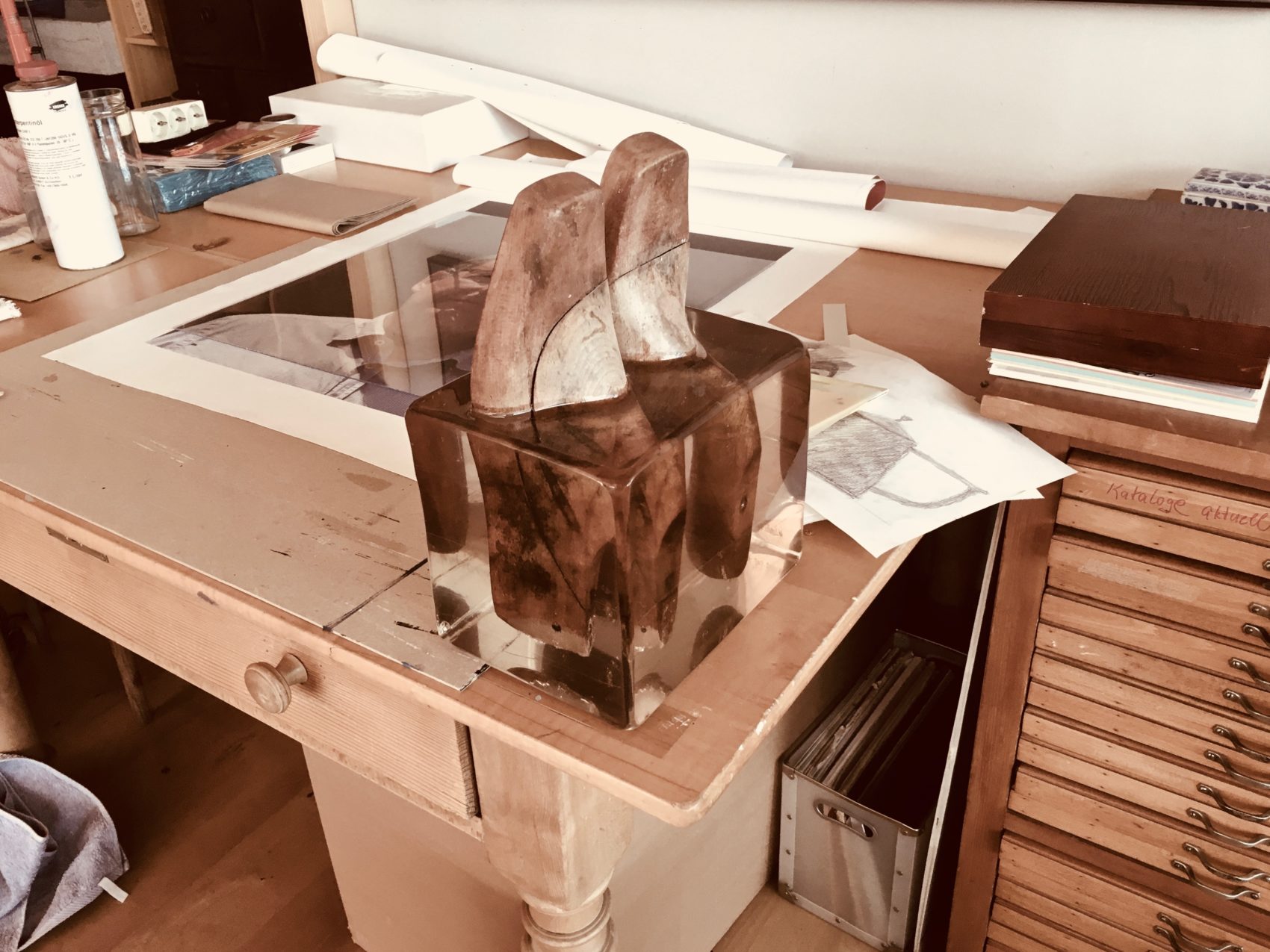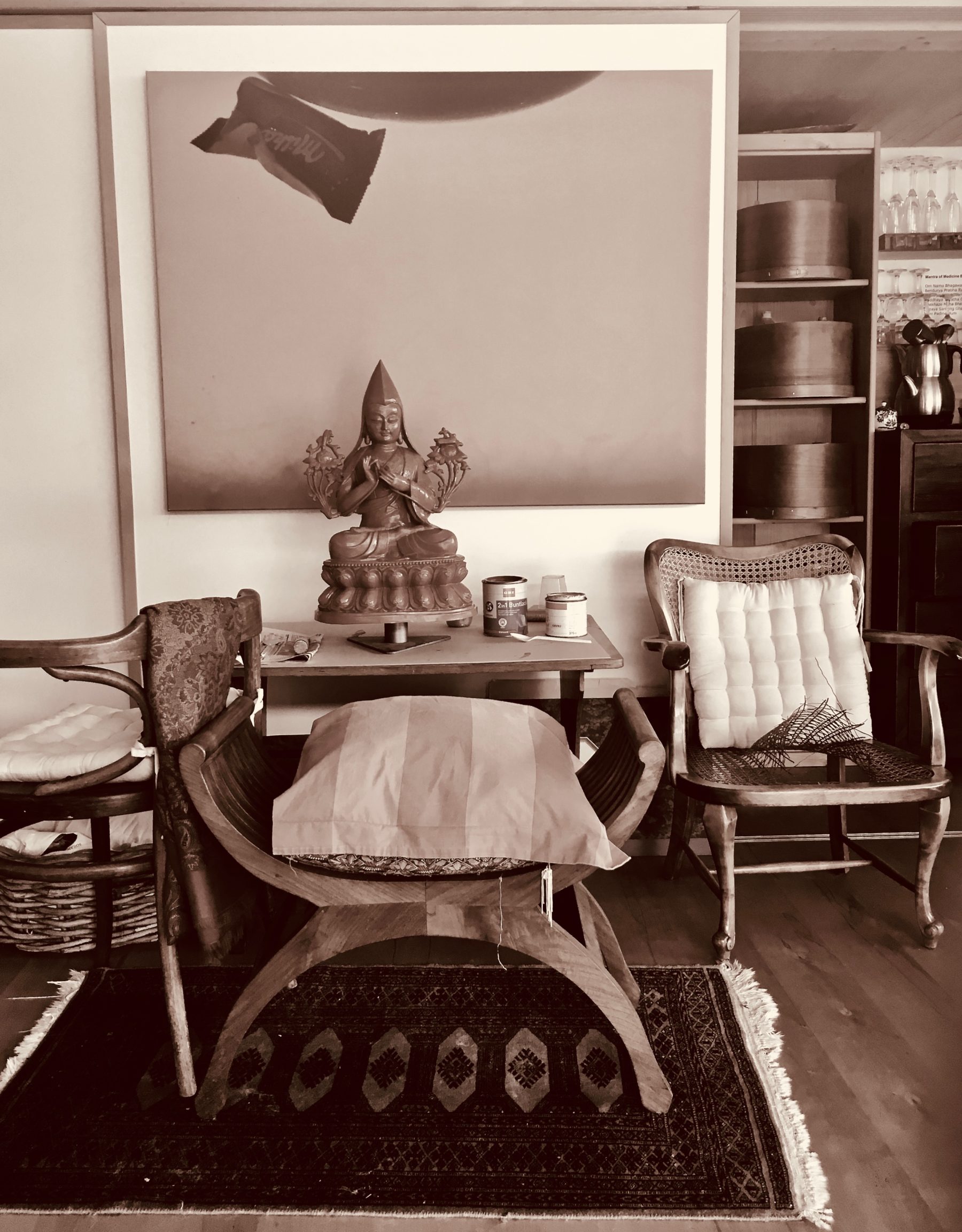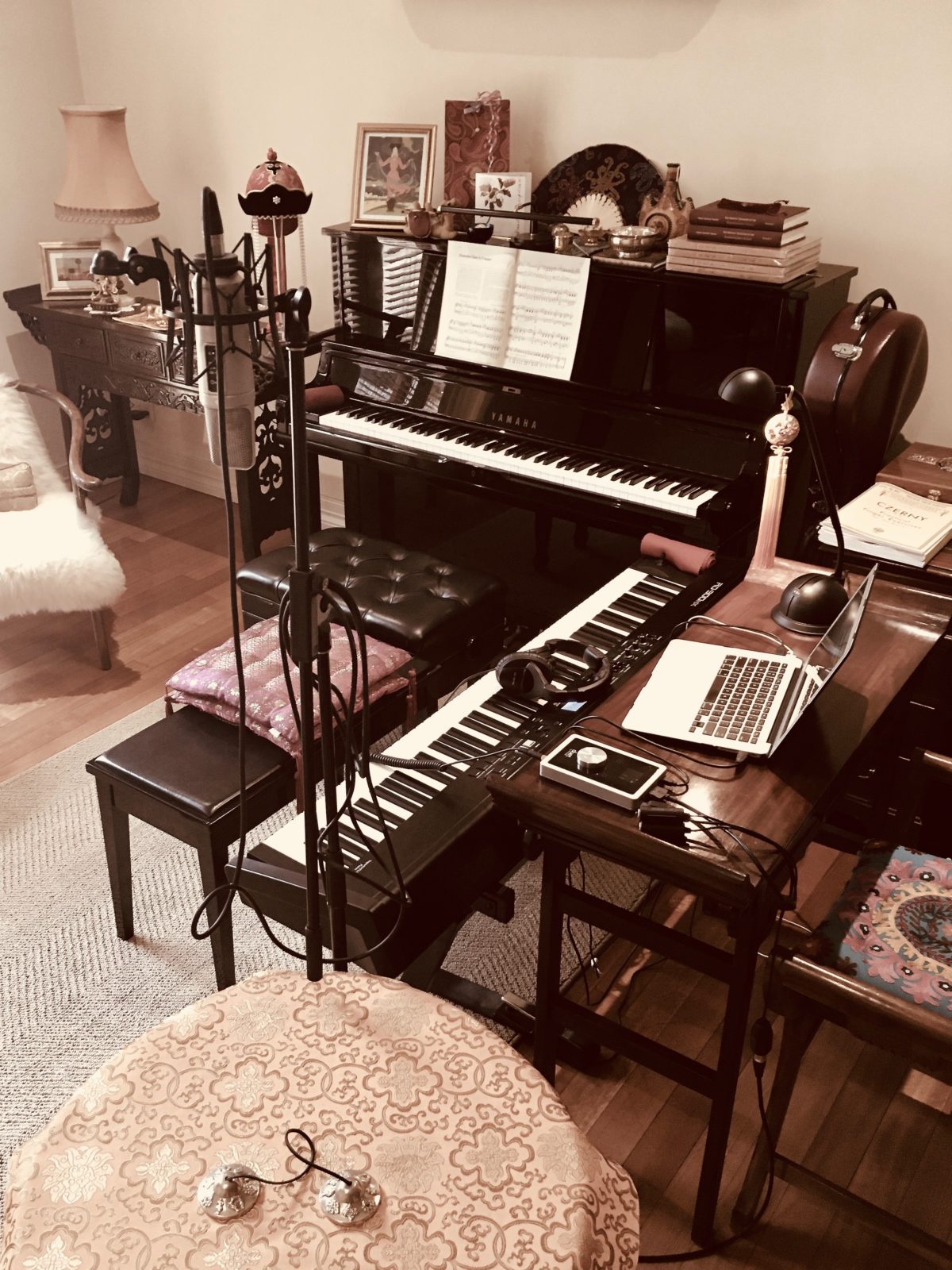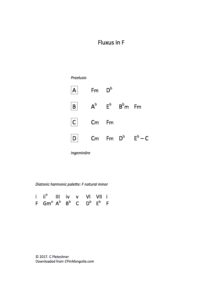This is the backstory to Soundscape 05: Fluxus in F for Adriana my video on You Tube.

Life on the road: scholarly books and other resources required for sabbatical, wrapped in silk, traditionally a sign of respect for learning and the learn-ed. Carry-on hand luggage. Not all important study sources can be obtained from Professor Google. Sometimes you still have to turn up. Tashi Rabten, Austria. 7 September 2017. Photo: C.Pleteshner
The idea for this multimedia project arose during time spent in Europe this Summer[1] with my generous and exuberant host, the Bavarian artist-pacifist Ruth Gschwendtner-Wolfle. The ‘Mongolian connection’ is explored further down this page. During my extended stay in Feldkirch in Austria I at times availed myself of Ruth’s beautiful old German studio grand piano, to sketch out musical ideas that I later recorded. I thank Ruth for her personal generosity in this regard. In her company, valued traditional practices and creative artistic innovation co-exist.
Can we ever r-e-a-l-l-y know what’s going on creatively in another person’s mind?
A ‘backstory’ — one word, first used in 1982 — details certain things that have happened before you hear, see or read about them on a screen. In the creative arts, the relationship between objects (the artefacts of creativity we value) and the narratives behind them are unmistakable. Current technologies of connection can help surface this idea in innovative and meaningful ways.
Context
Embedded in a backstory is the idea of ‘context’. Cultural anthropologists are taught that addressing notions of context in their exegeses and other writing such as fieldwork journals is critical to the task.
Yet, in the post-modern experimental movement the line between text and context is blurred (Denzin and Lincoln 2003a, pp4-5) especially when one is trying to integrate (multi-cultural) multimedia into an inter-disciplinary narrative in innovative ways. If simply a bricoleur or assembler of montages, then why do we labour so over the minutiae of what to actually use and what to leave out?
When we try to re-present or re-tell certain dialogic encounters that have seemingly created an important event in our lives, we change our account so that it makes more sense to the listeners at hand (Gershon 2012, p112, p116). It is so difficult to remove a conversation or an event from its original context when we give our account of it to others at a later time.
This is because conversations are contextually specific and include ‘deictic’ language. Deictic words (such as here, there, you, me) denote words whose meaning is dependent on the context in which they were being used at the time.
When works of art, like words, are signs that convey ideas, they are not things in themselves but symbols or representatives of things. Such a work is a medium, rather than an end in itself (Lippard and Chandler 1968).
This process of entextualisation is further compounded by the myth of singular authorship. So much of what we read, write and see now, is no longer ‘composed’ by one single person. ‘Composited’ might be a more accurate term.
In the Fluxus in F project, I draw on words (written by others) that have then been translated and interpreted from various languages (by others) into various scripts. I draw on such resources to convey a certain perspective, feeling and motivation; one that also introduces the next part of the story I set out to tell. Words from insightful scholars who perform their finely-honed art solely in the English language you will find here too.
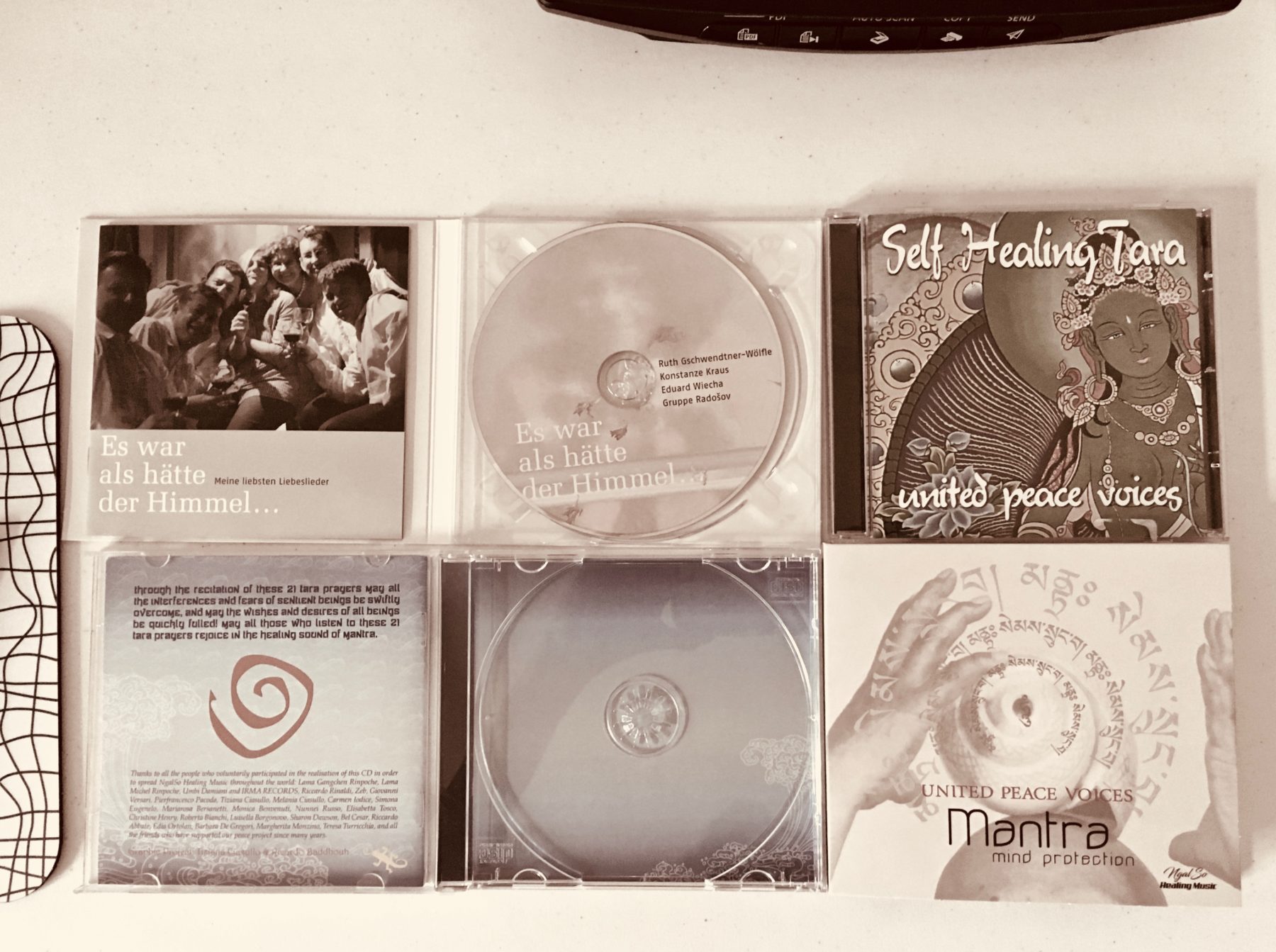
Multilingual digital artefacts of creative production (CD format) created by friends in Germany, Austria and Italy. 15 September 2017. Photographed in Melbourne studio: CP
Everyday life emerges from the unique contexts created by performer, genre, audience and setting. Throughout our daily interactions, and according to those contexts, we each deploy symbols and interpret them to help us organize ourselves and our experiences, and to find and create meaning in our lives (Robinson 2012, p84, p90). Some parts are just more artful than others.
Creativity is not a linear process. Solutions arrive unannounced.
As an instrument of human communication, digital media can broaden (as well as constrain) the context of an unfolding inter-personal relationship. Virtual reality technologies also allow us to be present and absent at the same time.
Such ‘technologies of culture’ allow us to engage with socially accepted norms of behavior whilst at the same time deviating from them. To illustrate this point, in the You Tube video I have reproduced contemporary VJ-ing-like animation (see below for details) in visual counterpoint to established and otherwise relatively static linguistic conceptions of Sarasvati, the ancient Indic patroness of learning, science, music and other expressive arts—and the watery, riverine flow of creativity she inspires (in Miranda Shaw, 2006. Plate 5 of Fig. 12.3 on p245 and pp235-236).
As the first musical instrument according to Indic mythology, her ‘vina’ (in my You Tube video referred to as ‘lute’, a more familiar term for non-expert readers), reflects Sarasvati’s role as originator and inspirer of the musical arts. Sarasvati’s association with the intellectual sphere also assures her favor among teachers and students of philosophy who highly value wisdom and its attendants: mental clarity, reasoning ability, oratory and other expressive skills.
We used to assume, that culture was a closed, coherent system of meaning and action in which an individual always and only participated (Agar 2012, pp24-26). You were a Mongol, a Tibetan, a Pole (with respect), a Han Chinese or a Kalmyk. You lived in a place that was relatively small and isolated, and your world was pretty much contained in that confined geographical space. The box was closed in time as well, because your culture was ‘traditional’. An oversimplification? Or parody perhaps?
Maybe not, for many of the nomadic pastoralists in Delgertsogt Sum in the Dundgovi Desert with whom I lived during my early years of fieldwork in Mongolia, the early post-soviet socialist years, still lived in a relatively socially and geographically constrained environment. This was at a time just after mobility (under the Soviets) was monitored and restricted, but before the exodus from countryside to city, the moving away from ‘the local’, emerged as the preferred, fashionable, economically imperative and desired destination to be.
In those earlier years of my observational fieldwork (2004 to 2010) so many things caught my attention (cf. ‘rich points’). They signalled differences between myself and what was going on around me at the time. ‘Such rich points are neither universal nor unique — nor are they random‘ (Agar 2012, p26).
The contrast between what I and the Mongol people around me considered ‘normal’ was remarkable. The importance and detailed qualities that, for example, these older generation ethnic Mongols attributed to ‘sky’ (Mong. Cyrillic ‘тэнгэр’) and the (attribute-laden) cloud formations that passed through it, I recount to this day.
Now why wouldn’t they? given the spectacular depth and vastness, the nuances of shape, colour and tone, and at times also the terrifying beauty of the sky out on the Mongol desert-steppe as mammoth cold weather fronts sweep in from the Siberian arctic to the North.
There was a time here when the sky was not polluted, nor hazed from the glare of bright coal-powered electrical city lights, or from dust raised by speeding vehicular traffic relentlessly transporting passengers and goods to and from somewhere else …
And so, ‘sky’ too has found its way into this, one of my more recent multimedia works.
The Sky Itself
I have a deep affection for Mongol art forms and culture.[2] The Sky Itself is by Inner Mongolian poet Ts. Tsolmon.[3] It has been translated and interpreted into English by the scholar-musician Simon Wickham-Smith (2015, p135). It is the first in a series of visuo-textual elements that make up the narrative fabric of the video.
The sky itself has no color
It is the distant and featureless border
that is a deep sky-blue
The sky itself has no light
It is the Sun, moving in the shape of a disc
that has a deep light
The sky itself has no voice
It is the broken rumbling melody
that has a deep sound
The sky itself is all alone
It is the stars, which shimmer into view
that are many
These verses may be interpreted in various ways. For me they bring a consideration of the always challenging philosophical topic of ‘Emptiness’[4] to the fore. Fluxus in F for Adriana the musical composition, fits neatly, like a dovetail joint chiseled by master cabinet-maker Norbert, into the third verse of this poem at the video’s introductory Mongolian poetic node.
Multiple modalities, anthropology and eisegesis
In terms of ‘social anthropologist as author’ (Czarniawska 2004, p105, cf. Geertz 1988), anthropology is not a matter of sorting strange facts into familiar categories but rather a kind of writing. The process of eisegesic commentary, where our own subjective interpretations are drawn into creating narrative texts, is also important here.
Without eisegesis would we have art?
Anthropologists struggle, as Clifford Christians (2003) points out, with issues of voice and reflexivity and how to locate ourselves and those with whom we associate and about whom we write (see Denzin and Lincoln 2003b, pp49-50). Considerations of social responsibility and a personal position regarding an ethics of inquiry are also intrinsically? embedded in a serious composition of reflexive text.
If considerations of ‘voice’ and ‘reflexivity’ are in fact primary (I would argue that they are), then the textual ‘signature’ for this project (Fluxus in F) is that of ‘author-saturated’ (Czarniawska 2004, pp105-108), written and presented ‘through and across’ multiple narrative modalities, not just one separate and singular expositional form. Therein, has been the challenge.
<Yoda> The learning curve is steep and the path full of obstacles </Yoda>
This curatorial essay (of which you are about half-way through) and the accompanying You Tube video each have a ‘narrative trajectory’ (see Greimas and Courtes 1982).
The visual ‘polyphony’ of the You Tube video can be described in terms of the concept of ‘variegated speech’ (heteroglossia), with ‘voices’ from different dialects (Bakhtin and Medvedev 1928/1985). As a defined entity, the work incorporates visual, articulated auditory ideas, as well as arguments and thoughts expressed in written words in English and other scripts.
In the video, I also hope to have achieved some degree of congruence between the various aspects of its ‘story’—that of scene, act, agent, agency and purpose (Burke 1945/1969, cf. Kenneth Burke’s Pentad).
And, if we assume that in terms of interpretation, ‘meaning’ is the product of an interaction between the interlocking text/s and its reader (Iser 1978)—here, ‘readers’ (i.e. you) are free to interpret the video’s and these various other ‘texts’ as you each see fit. Whilst the texts are not open to limitless possibilities in terms of interpretation (cf. ‘intentio operis’ in Eco 1992), I have tried to give equal importance to both text/s and reader in how the work has been laid out.
A concise analytical contemplation on the nature of ‘sound’ and ‘sonic art’
Sound, like water, has no border, no clear outline to distinguish it from not it. The only way to designate a specific sound: to say this sound or that sound, is to create a boundary for the sound as a dam does for water. (Kim-Cohen 2017, p51)
Sound is ‘not obviously divisible’ but not because the body of sound is indivisible. Such a body, imagined as contained and containable, as distinct from that which is not it, is a fiction. There is no hard division between sound’s inside and outside. The imprecision of the figure of the sonic body occurs not at the level of the sonic, but in the metaphor of sound idealized as a body. (Kim-Cohen 2017, p54)
To think of sound as the perfect example of the dematerialisation of the art object is to misunderstand sound and, maybe also, to overlook the more lasting, and recently prevalent, legacy of conceptualism. It is more accurate to say that sound is an example of the de-objectification of artistic material. (Kim-Cohen 2017, p55)
What we recognize as a sound or a work is constructed as a nexus of parergonal forces that generate the illusion of a self. Sound does not occupy a stable, identifiable position but exists in and as a flexible, movable ‘time-place‘ the designated nexus of temporal and material forces described here. (Kim-Cohen 2017, p54, p59)
The listening subject has neither the privilege nor the power to determine which aspects of a sound work’s context are constitutive. Contexts impose themselves: past experiences, future expectations, adjacent sounds, other works, institutional settings, curatorial framing. All these influences, and other parerga besides, are essential components of our experience of what we call ‘the work’. (Kim-Cohen 2017, p54)
Fluxus in F for Adriana: the sonic landscape
The music for Fluxus in F for Adriana was composed for a friend who was in Switzerland on sabbatical from the University of São Paulo at the same time I was studying there too. It is from this simple initially-acoustic musical node that the other artifacts (digital sounds, images and written narratives texts) on this ‘dual-platform blog-work’ (website & You Tube) were progressively created and assembled.[5] [6]
The music and accompanying ‘moving pictures’ (cf. animations) can be seen as a reflection of two sources of inspiration: one globally modern and dynamic (VJ-ing, live coding), the other Eurocentric, certainly grounded in practice and somewhat traditional (Carl Czerny). Educational objectives, like most research articles on my blog, underpin the arc of how and what I write.
VJ-ing and live coding performances
‘VJ-ing’ (pronounced: vee-jay-ing) is a type of real-time performance where imagery is manipulated through technological mediation in synchrony to music. As we learn to work with developing and increasingly powerful authoring tools, vj-ing is being incorporated into an array of performing art forms.
Did you know that at live performances such as dance parties, ‘the beat’ (and its ‘western’ influence on the heart-body circulatory system) is used to progressively lift the mood-energy of an audience? The underlying beat of the music starts at 120 bpm (beats per minute). To ‘consolidate’ the mood of an audience the next piece is around 125 bpm. From here it is increased to 126bpm and then up to ‘an optimum’ of 128bpm. Fascinating …
Whilst in VJ-ing multimedia performances are central, the ‘real-time’ processing of the visual material for this performance mode, although popular, was not the favoured or most practical option for me. I have yet to embrace You Tube’s live-streaming mode of delivery and have other places I like to be other than live streaming (for the sake of performance) from my desk.
I have, however, used generative (algorithmic) and other software to produce the ‘synthesthetic experience’ of vision and sound for the Fluxus in F for Adriana on You Tube mix. In western art music, the incorporation of electronically produced sound into such compositional practice originated during the middle of the 20th Century.[7]
A more recent innovation in DJ programming that has caught my attention recently, is that of ‘live coding’, although it is not (yet) my thing. Using a concurrent programming language, live computer ‘coding’ (not ‘coded’) musical concerts (across all genres) are being performed in front of audiences in both physically proximal and virtual surrounds.
The music (i.e. sonic landscape) is created by a musician-art-programmer. Watching how s/he codes/creates live is what the audience watches (with close scrutiny) as a real-time ‘performance’ of this art is projected (from the authoring computer) onto a big screen.
For digital (performed in public) extemporization personified, take a look at Australian artist/music programmer Andrew Sorensen (Queensland University of Technology, Australia) on You Tube for a virtuoso example of this emerging and fluxus-related compositional mode.
The other source of inspiration … ?
I continue to have a fascination with the stylistic approach of the Austrian composer-teacher-pianist of Czech origin, Carl Czerny (1791–1857) especially his extensive portfolio of pianistic skill development techniques. The desire to connect with such an original and culturally embedded approach and its musical properties is an integral part of the contemporary music and art-making process.[8]
Fluxus in F for Adriana: the musical composition and its production
In Fluxus in F for Adriana I try to emulate the beautiful sound of Czerny’s exacting precision and inventiveness within a clearly proscribed 12 note diatonic harmonic palette of my own choosing (see below). I then worked with the sonorities and tensions that reside therein. I would describe this particular variation of the composition as ‘energetic’. Other variations have different ‘feels’.
For this variation, I have used real-time improvisation on a full size digital piano and algorithmic computer technology to create vertically organized layers and varying densities of sound. In another dialogic context, this could be described as primarily a triadic landscape. Yet with precision and harmonic palette set aside, inventiveness with sonorities becomes the key.
To hear the progressive shifts in harmonic layering, how the sounds subtly change and transform over time, and to pick up percussive detail, listening to the You Tube video with a good set of (circumaural) headphones is recommended. Not a loop, the musical composition is about 8:00 minutes in length and starts at around 0:58 seconds into the video.
At times, the music and concurrent appearance of moving images is asynchronous. This is not an error of technical implementation, rather a way of embedding the notion that inter-cultural boundaries are not as porous, nor as ‘harmonised’ (a managerial term) as we would like.
Fluxus with a capital ‘F’
For artists and other intelligent people au fait with such matters, this short section may be of little interest beyond a cursory reading and then critique. However, for the rest of us, the uninitiated, some information about ‘Fluxus’ may be of interest, especially how it relates to my own work here.
The progenitor of Fluxus as a social movement was George Mačiūnas (1931-1978), a Lithuanian-American installation and performance artist. He is widely considered (in retrospective art history circles) to have been the founding central coordinator of the international community of initially New York City ‘happening’ artists, composers and designers of the 1960s and 1970 sassociated with Fluxus (with a capital F).
Jon Hendricks (in his foreword to Schmidt-Burkhardt 2011, pp7-8) describes Maciunas as someone who, ‘was constantly gathering data and devising ways to store it and to access it.’ His way of thinking enabled him to organise a vast array of art-history, Fluxus-related events, publications and information all in a pre-computer age.
In Europe, particularly in Germany and France, ‘performance art’ was a very important part of the post WW2 experience, as then-contemporary artists in Europe reconnected with pre-WW1 art movements (such as Dada) and especially for German artists who reconnected with their own notions of avant-guarde pre-Nazi art forms.
Fluxus was initially an avant-garde movement characterized by an observable ‘subversion’ of previous art traditions. The experimental music, event scores and public performances of theorist-composer John Cage (1912-1992) and the conceptual art of New York-born George Brecht (1926-2008) are primary illustrative examples.
The first collections of Fluxus ‘event scores’ were used only by the artist-performers presenting the works. Progressively (seen in retrospect), these evolved into three categories of form: (i) a boxed collection of individual scores printed on cards; (ii) a book or pamphlet collection of scores presenting the work of a single artist; and (iii) small collections of scores in pamphlet format representing many other artists working in the then-young inter-media tradition (Friedman, Smith, and Sawchyn 2002).
From the late 1950s, when the thirty or so Fluxus artists first came together in situations linked to experiments in musical education (Higgins 2002, p1, pxiii), until now, there continues to be a lack of consensus among Fluxus commentator-art historians in terms of defining the Fluxus style that was, and that is now, several generations later.
Such indeterminacy (embodied by those who commentate) is part of the Fluxus appeal. When recently asked by a friend, ‘How would you describe the genre of your work?’ My answer was, ‘I am not at all sure where it fits in.’
If you are a pianist and enjoy exploring acoustic pianistic sound, you may like to listen to John Cage’s Ocean of Sounds and In a Landscape (1948). Both compositions are longer than today’s formulaic pop song 3 minute wrap.
fluxus in F: a harmonic palette
The following .pdf is a simplified version of the Fluxus is F for Adriana[9] harmonic palette. The recording on You Tube differs from that which is sequentially mapped out here. Creativity is thus built into resolving this disjuncture, with yet to be realised artistic potential for interplay.
‘fluxus’ is also the Latin word for flowing. In English a ‘flux’ is a flowing out
It is a simple sequence of related chords in keeping with expected conventions associated with such things. The schema’s presentation, however, is somewhat of a hybrid that draws on a trained musician’s tacit knowledge of western diatonic harmony. It combines (short-hand) notational symbols and queues for musicians from both classical and jazz-oriented forms.
Hence all the necessary information is present should you now wish to explore creating your own sound with this palette, on the musical instrument/s of your own choosing, in tandem or without your ‘experience’ of Fluxus is F for Adriana on You Tube.
Often, those of us who would otherwise be spectators in contemporary (upper-case F) Fluxus-related performances are instead invited to be actively involved (see Dezeuze 2012). I wonder how such an invitation to participate might affect the perceived value or status of the work? Moreover, how could such an opportunity proferred change our otherwise virtual, anonymous, passive-observer experience in some way?
Acknowledgements
During my annual study pilgrimages, an unbroken practice since 1987, I have often considered what it means to be with Kalyānamitra. I reflect on the many dialogical encounters and other interactions I am having with the generous others of whom I am a live-in guest for a time. My recent stay in various yet related locales across Europe is no exception.
Do my contributions and interactions actually help anyone? Do they make a difference, in some wholesome way? Do they maintain, or just strain otherwise established and sanctioned norms of behaviour at a particular socio-cultural hub?
A predisposition towards lesser formality and the desire to investigate further, research and learn, locates me elsewhere to that of the uninitiated observer. As to where that is exactly? I am still unsure—because everything just keeps changing. What I thought once was, has now ceased to be. What I can say with confidence however, is that my recent exchanges with old and now new friends in Europe were not only harmonious and nurturing, but also intellectually and creatively stimulating to say the least! Here, I do not feel the need to mention names. You know who you are.
References
Agar, Michael. 2012. “Culture: can you take it anywhere?” In A Cultural Approach to Interpersonal Communication, edited by Lelia Monaghan, Jane E Goodman and Jennifer Meta Robinson, pp24-26. Chichester, West Sussex: Wiley-Blackall.
Bakhtin, Mikhail M, and P N Medvedev. 1928/1985. The Formal Method in Literary Scholarship: a critical introduction to sociological poetics. Cambridge, MA: Harvard University Press.
Buescher, John B. 2005. Echoes from an Empty Sky: The Origins of the Buddhist Doctrine of the Two Truths: Snow Lion Publications.
Burke, Kenneth. 1945/1969. A Grammar of Motives. Berkeley, CA: University of California Press.
Burton, David. 2001. “Is Madhyamaka Buddhism really the middle way? Emptiness and the problem of nihilism.” Contemporary Buddhism: An Interdisciplinary Journal 2 (2):177 – 190.
Christians, Clifford G. 2003. “Ethics and Politics in Qualitative Research.” In The Landscape of Qualitative Research: theories and issues, edited by Norman K Denzin and Yvonna S Lincoln, 208-243. Thousand Oaks: Sage.
Czarniawska, Barbara. 2004. Narratives in Social Science Research. Edited by David Silverman, Introducing Qualitative Methods. London: Sage.
Denzin, Norman K, and Yvonna S Lincoln. 2003a. “Introduction: The Discipline and Practice of Qualitative Research.” In The Landscape of Qualitative Research: theories and issues, edited by Norman K Denzin and Yvonna S Lincoln, pp1-46. Thousand Oaks: Sage.
Denzin, Norman K, and Yvonna S Lincoln. 2003b. “Part 1: Locating the Field.” In The Landscape of Qualitative Research: theories and issues, edited by Norman K Denzin and Yvonna S Lincoln, pp47-244. Thousand Oaks: Sage.
Dezeuze, Anna, ed. 2012. The ‘do-it-yourself’ artwork: participation from Fluxus to New Media. Manchester, UK: Manchester University Press.
Eco, Umberto. 1992. Interpretation and Overinterpretation. Cambridge: Cambridge University Press.
Friedman, Ken, Owen Smith, and Lauren Sawchyn, eds. 2002. The Fluxus Performance Workbook (40th Anniversary Edition). A performance research e-publication.
Geertz, Clifford. 1988. Works and Lives: The Anthropologist as Author. Stanford, California: Stanford University Press.
Gershon, Ilana. 2012. “And Then She Texted Me: entextualisation and the end of relationships.” In A Cultural Approach to Interpersonal Communication, edited by Lelia Monaghan, Jane E Goodman and Jennifer Meta Robinson, pp110-119. Chichester, West Sussex: Wiley-Blackall.
Greimas, Algirdas Julien, and Joseph Courtes. 1982. Semiotics and Language: an analytical dictionary. Bloomington, Indiana: Indiana University Press.
Higgins, Hanna. 2002. Fluxus Experience. Berkeley, California: University of California Press.
Iser, Wolfgang. 1978. The Act of Reading: A theory of aesthetic response. Baltimore, MD: John Hopkins University Press.
Kim-Cohen, Seth. 2017. “Dams, Weirs, and Damn Weird Ears: post-ergonal sound.” In The Routledge Companion to Sounding Art, edited by Marcel Cobussen, Vincent Meelberg and Barry Truax, pp51-60. New York: Routledge.
Kosuta, Matthew. 2007. “Theravada Emptiness: the Abhidhammic theory of Ajaan Sujin Boriharnwanaket.” Contemporary Buddhism: An Interdisciplinary Journal 8 (1):19 – 29.
Lippard, L. R., and J Chandler. 1968. “The Dematerialization of Art.” Art International 12 (2): pp31-36.
Lopez, Donald S. 1996. Elaborations on Emptiness: uses of the Heart Sutra. Princeton N.J.: Princeton University Press.
Mend-Ooyo, Gombojav. 2007. Nomadic Lyrics (translated from the Mongolian by Simon Wickham-Smith). Ulaanbaator: Mongolian Academy of Culture and Poetry.
Newland, Guy. 2008. Introduction to Emptiness as taught in Tsongkhapa’s Great Treatise on The Stages of the Path. Ithaca, New York: Snow Lion.
O’Grady, Paul. 2005. “Form and Emptiness: Aquinas and Nagarjuna.” Contemporary Buddhism: An Interdisciplinary Journal 6 (2):173 – 188.
Pema Tsewang Shastri. 2012. Like a Yeti Catching Marmots. Boston: Wisdom Publications.
Robinson, Jennifer Meta. 2012. “Saying Hello in a Digital World: emergent performance and social competence.” In A Cultural Approach to Interpersonal Communication, edited by Lelia Monaghan, Jane E Goodman and Jennifer Meta Robinson, pp84-92. Chichester, West Sussex: Wiley-Blackall.
Schmidt-Burkhardt, Astrit. 2011. Maciunas’ Learning Machines: from art history to a chronology of Fluxus (Second Edition). New York: Springer
Shaw, Miranda. 2006. “Sarasvati.” In Buddhist Goddesses of India, 234-46. New Jersey: Princeton University Press. pp234-246.
Ts Tsolmon. 2015. A Floral Wind: selected poems, translated from the (Inner) Mongolian by Simon Wickham-Smith. Ulaanbaator: Mongolian Academy of Culture and Poetry.
Footnotes
[1] During the summer of 2017, I continued my formal philosophical studies with Teachers in centres of learning in Austria, Switzerland and Italy. Mongolian people I know also travel to centres in Europe for such educational purposes or to visit their children who are studying there.
[2] I would like to think that I am thereby refraining from (as the Tibetan proverb suggests), Throwing away an amber stone, when turquoise and ruby become available (Pema Tsewang Shastri 2012, p146).
[3] Ts. Tsomon was born in 1963 in Havchig, Xilin Gol Aimag
[4] See: Newland 2008, Kosuta 2007, Buescher 2005, O’Grady 2005, Burton 2001 and Lopez 1996.
[5] Producing a coherent and interoperable multimedia work ‘through and across’ new technologies presented a new set of conceptual and technical challenges for me. It’s not at all like what the individual proprietary-software marketers and vendors say. Moving a range of media formats ‘through and across and into’ is a rocky terrain of its own. Undaunted, I continue to invest in learning to navigate and use new software and apps, not all of which, predictably, are interoperable. This is not news to anyone who has tried to ‘efficiently’ produce works that integrate ‘across’ musical, visual and textual modality production on more than one online delivery platform.
Oh, and let’s not forget the need for bibliographic records in a searchable database and other ‘knowledge organization’ as the need to catalogue scholarly (cf. citable references in a bibliographic database such as Endnote for example) and multimedia items (cf. photographs, MP4s, diagrams, texts and other artifacts) manifestations, expressions, works [FRBR] and containers [MLA] increases for digital artefacts not only to be stored for future use but so that they can also be located with relative ease (efficiency). Now where’s that sound file of that Khoomii (overtone singing) I recorded in that ger camp near Mandalgovi late one night, back in the summer of 2005? … and so it goes …
[6] More than one hyperlink to the related You Tube video component of this post have been implemented at logical junctures in the narrative in order to facilitate follow up and return between the two hosting platforms.
[7] Electroacoustic Music on Wiki offers a great summary and introduction.
[8] See: The Art of the Pinch (Mitch Goodwin. Curriculum Design Lab, University of Melbourne) Retrieved: 21 December 2017.
[9] Fluxus in F for Adriana on You Tube is one realized manifestation of a number of digitally embodied ‘expressions’ of the same ‘work’ or ‘container’. In addition, real time, non-recorded public and private acoustic, and at other times also digital keyboard performances, exemplify other ‘items’ that make up this ‘portfolio work/container.’ I am currently experimenting with using these FRBR and MKL categorical identifiers, just trying them out to see if they add value and coherence to my work.
Soundscape 05: Fluxus in F was researched and written by Catherine Pleteshner.
Attribution
In keeping with ethical scholarly research and publishing practices and the Creative Commons Attribution 4.0 International License, I anticipate that anyone replicating the photographs or translating into another language all or part of this article and submitting it for accreditation or other purpose under their own name, to acknowledge this URL and its author as the source. Not to do so, is contrary to the ethical principles of the Creative Commons license as it applies to the public domain.
CP in Mongolia on You Tube
Refer to the INDEX for other articles that may be of interest.
© 2013-2024. CP in Mongolia. The post ‘Soundscape 05: Fluxus in F’ is licensed under the Creative Commons Attribution 4.0 International License. Artefacts represented and documents linked from this page may be subject to other restrictions. Posted: 1 January 2018. Last updated: 20 June 2022.
